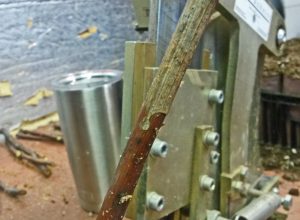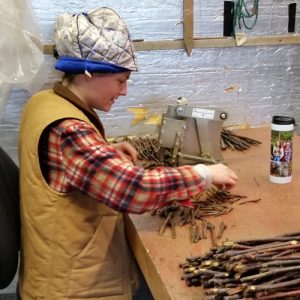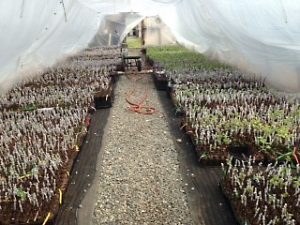As the rain pours down outside and the wind howls off the mountain through this cold and dreary spring, a crew of diligent grafters works away in the little propagation house behind the nursery. They are grafting grape vines, literally building the plants that will eventually become the vineyards throughout our region. If you’ve enjoyed a glass of wine recently, especially one from vines grown west of the Cascades, send out a little thanks to these folks right now. It may very well have had its beginnings right here in this little room.
“Kachunk…Kachunk…Kachunk.” The steady rhythm of the pedal driven grafting machine underscores all conversation in the propagation house, and if the crew is like me, it probably follows them into their dreams as well. We hear that sound a LOT! On a typical day we graft over a thousand vines, and for 4-6 weeks every spring, this consumes our world of plant propagation as we pump out anywhere from 15,000 to 30,000 new vines.
Luckily we have that machine I mentioned above. A highly engineered piece of German equipment, it simultaneously makes omega shaped cuts in both the rootstock and the scion and joins the two pieces together with one kick of the foot. It can do in less than a second what would take an experienced grafter close to a minute, and with greater accuracy and consistency.
That’s not to say that there’s no work left for us humans, though. Between harvesting the sticks and planting the newly grafted vines out in the field, we touch those sticks no less than 21 different times at various stages in the process. It’s complicated, it’s exacting, and it’s full of potential pitfalls, but grafting onto a rootstock is essential in our maritime climate with its cool, short summers and fall rains.
The rootstocks we choose encourage earlier ripening by as much as 1-2 weeks, and that’s often enough of an advantage to ripen fruit successfully and get it harvested before the rains arrive. We’ve been trialing wine grapes and rootstocks here at the farm for over 20 years, and we are getting a pretty good picture of how the different rootstocks perform, how the different varietals fare through the season, and how to turn these grapes into a good bottle of wine.
If you’re interested in learning more about the trials or about the nearly 100 varieties of grapes that we grow, call us, swing by the nursery, or sign up for one of our grape growing workshops. You can also order vines and find information about growing wine grapes in our climate by visiting our website.





Can the Omega grafting machine graft apple pear fruit seedlings, thanks for the reply
We have used it but it works better for softer wood.
Yes, of course it does. All my apple trees have been grafted in omega style. The apple grafting is one of the easiest and this omega graft gives good grasp and resistance. Good luck!